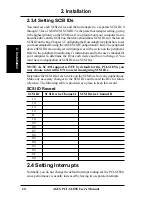
ASUS PCI-SC896 User’s Manual
31
4. Appendix
4. Appendix
IRQ - Interrupt Request Channel. A path through which a device can get the
immediate attention of the computer’s CPU. The PCI bus assigns an IRQ path
for each SCSI host adapter.
ISA - Industry Standard Architecture. A type of computer bus used in most
PC’s. It allows devices to send and receive data up to 16-bits at a time.
Kbyte - Kilobyte. A measure of computer storage equal to 1024 bytes.
Local Bus - A way to connect peripherals directly to computer memory. It
bypasses the slower ISA and EISA busses. PCI is a local bus standard.
Logical Unit - A subdivision, either logical or physical, of a SCSI device (ac-
tually the place for the device on the SCSI bus). Most devices have only one
logical unit, but up to eight are allowed for each of the eight possible devices
on a SCSI bus.
LUN - Logical Unit Number. An identifier, zero to seven, for a logical unit.
LVD - Low-Voltage Differential. LVD is a robust design methodology that im-
proves power consumption, data integrity, cable lengths and support for multiple
devices, while providing a migration path for increased I/O performance.
Mbyte - Megabyte. A measure of computer storage equal to 1024 kilobytes.
Main Memory - The part of a computer’s memory which is directly acces-
sible by the CPU (usually synonymous with RAM).
Motherboard (Mainboard ) - A large circuit board that holds RAM, ROM,
the microprocessor, custom integrated circuits, and other components that make
a computer work. It also has expansion slots for host adapters and other expan-
sion boards.
Multi-tasking - The executing of more than one command at the same time.
This allows programs to operate in parallel.
Multi-threading - The simultaneous accessing of data by more than one SCSI
device. This increases the data throughput.
NVRAM - Non Volatile Random Access Memory. Actually an EEPROM (Elec-
tronically-Erasable Programmable Read Only Memory chip) used to store con-
figuration information. See EEPROM.
Operating System - A program that organizes the internal activities of the
computer and its peripheral devices. An operating system performs basic tasks
such as moving data to and from devices, and managing information in memory.
It also provides the user interface.



































